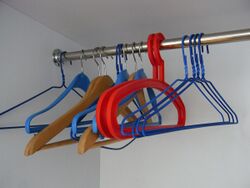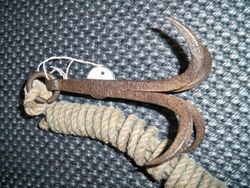Engineering:Hook



A hook is a tool consisting of a length of material, typically metal, that contains a portion that is curved/bent back or has a deeply grooved indentation, which serves to grab, latch or in any way attach itself onto another object. The hook's design allows traction forces to be relayed through the curved/indented portion to and from the proximal end of the hook, which is either a straight shaft (known as the hook's shank) or a ring (sometimes called the hook's "eye") for attachment to a thread, rope or chain, providing a reversible attachment between two objects.
In many cases, the distal end of the hook is sharply pointed to enable penetration into the target material, providing a firmer anchorage. Some hooks, particularly fish hooks, also have a barb, a backwards-pointed projection near the pointed end that functions as a secondary "mini-hook" to catch and trap surrounding material, ensuring that the hook point cannot be easily pulled back out once embedded in the target.
Variations

- Bagging hook, a large sickle or reaping hook used for harvesting grain[1][2]
- Bondage hook, used in sexual bondage play
- Cabin hook, a hooked bar that engages into an eye screw, used on doors[3][4]
- Cap hook, hat ornament of the 15th and 16th centuries
- Cargo hook, different types of hook systems for helicopters
- Crochet hook, used for crocheting thread or yarn
- Drapery hook, for hanging drapery
- Dress hook, fashion accessory
- Ear hook, to attach earrings
- Fish hook, used to catch fish
- Flesh-hook, used in cooking meat
- Grappling hook, a hook attached to a rope, designed to be thrown and snagged on a target
- Hook and chain coupler, mechanical part for the coupling for railway vehicles
- Hook (hand tool), also known as longshoreman's hook and bale hook, a tool used for securing and moving loads
- Hook-and-eye closure, a clothing fastener
- Hook-and-loop fastener, a type of textile fastener
- Hook hand, also called prosthesis, an artificial hand replacement made from a hook
- Lifting hook, for grabbing and lifting loads
- Mail hook, for grabbing mail bags without stopping a train
- Meat hook, for hanging up meat or carcasses of animals in butcheries and meat industry
- Prosthetic hook or transradial prosthesis, part of a prosthetic arm for amputees
- Purse hook, used to keep a woman's purse from touching the floor
- Shepherd's hook, a staff used in herding sheep or other animals
- Siege hook, an Ancient Roman weapon used to pull stones from a wall during a siege
- Tailhook, used by aircraft to snag cables in order to slow down more quickly
References
- ↑ Unger-Hamilton, Romana (July 1985). "Microscopic Striations on Flint Sickle-Blades as an Indication of Plant Cultivation: Preliminary Results". World Archaeology 17 (1): 121–6. doi:10.1080/00438243.1985.9979955.
- ↑ Banning, E.B. (1998). "The Neolithic Period: Triumphs of Architecture, Agriculture, and Art". Near Eastern Archaeology 61 (4): 188–237. doi:10.2307/3210656.
- ↑ Beazley, Elisabeth (1990). Beazley's Design and Detail of the Space Between Buildings. Taylor & Francis. pp. 230. ISBN 978-0-419-13620-0.
- ↑ Porter, Brian; Christopher Tooke (2007). Carpentry and Joinery 3. Butterworth-Heinemann. pp. 200. ISBN 978-0-7506-6505-6.
 |






